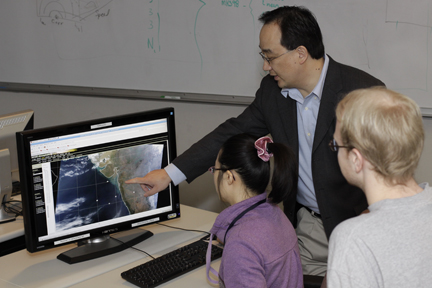UND Researcher discusses climate change & aerosols at #SF2011und.
Dean’s Lecture Series: Dr Jianglong Zhang, Atmospheric Sciences
by Elizabeth Howell
Cited by President Barack Obama in 2009 as one of the United States’ most promising young researchers, Jianglong Zhang – an assistant atmospheric sciences professor at the University of North Dakota – will tackle climate change and aerosols in a Dean’s Lecture at the Graduate School’s 2011 Scholarly Forum on Wednesday, March 9.
Dr. Zhang, a native of central China, holds degrees from Peking University and the University of Alabama, and has been at UND since 2007.
He spoke with UND about past global successes in aerosol elimination, such as cleaning up London’s polluted atmosphere in the 1950s. But there is much more to do.
UND: In a few sentences, can you give me a summary of the research you will present at the 2011 Graduate School Scholarly Forum?
JZ: Climate change is a well-known topic to the public. Yet, many may not be aware that the climate system is complex with various factors interacting with each other. The effect of aerosols is one of the most important and least understood factors. In my talk, I will briefly discuss recent scientific advances in aerosol and climate studies, including the direct and indirect aerosol climate impacts. Other aspects of ongoing aerosol research, such as visibility and air quality studies will also be discussed. Finally, recent results of simulations performed by our research group will be presented.
UND: You talk also about aerosol and cloud interactions. For the benefit of readers who may not understand how that works, can you describe how aerosols affect cloud formation, and the implications for climate change?
JZ: Aerosols can act as cloud condensation nuclei or “cloud seeds” for forming clouds. An increase in aerosol concentrations could vary the size distributions of cloud droplets and thus influence cloud properties (e.g. make clouds brighter, thus reflecting more sunlight back to space), and alter cloud lifetime. Both of these effects can result in less sunlight reaching the ground and reductions in surface temperatures. Therefore, by modifying cloud properties (e.g. creating brighter and longer lived clouds), aerosols could indirectly impact climate.
UND: How much do we know about the quantity and type of aerosols added to the atmosphere every year?
JZ: We have some understanding of aerosol emissions (with uncertainties) from major aerosol types, such as dust and sea-salt aerosols. However, aerosol physical and chemical properties, which are highly variable in both space and time, that are crucial to aerosol and climate impacts. These properties are not well understood.
UND: NASA’s Glory spacecraft launched Feb. 23; part of its mission will be to identify aerosols in the atmosphere by measuring the light scattered from aerosol particles. What sort of benefits will this bring for aerosol research?
JZ: I am very excited about the upcoming NASA Glory mission. Instruments on board the Glory mission include the Aerosol Polarimetry Sensor (APS), which provides multi-spectral, multi-angle and polarized observations of the Earth’s atmosphere with unprecedented accuracy. This instrument will allow us to obtain accurate measurements of aerosol optical properties, including aerosol optical depth, size distribution, refractive index, and single scattering albedo, all of which are much needed to push aerosol science forward. I believe the glory mission will greatly advance our understanding of aerosol direct and indirect climatic impacts.
UND: Is there a success story concerning the reduction of a certain type of aerosol, which in turn gave a positive effect on the environment, that you can share?
JZ: London fog would be a perfect example of such. In the 19th and early 20th century, coal was widely used as a means of winter heating in London. Large quantities of smoke were generated from coal burning. Smoke particles, sulfate aerosols and other gaseous constituents, mixing with the local metrological conditions, formed a famous historical phenomenon called “London Fog” or “Pea Soupers”. It was not until the “great smog” of 1952 that killed more than 4,000 people did the Londoners realized the seriousness of the problem. A clean-air act was passed in 1956.
UND: In your view, how well do we understand the effect of aerosols on climate change — and where can we improve?
JZ: Based on the recent Intergovernmental Panel on Climate Change (IPCC) report, we have an improved understanding of the aerosol direct effects, although with large uncertainties. However, our understanding of aerosol indirect effects (aerosol and cloud interactions) is still very limited. We need to continuously put efforts into three directions: surface, in situ, and field experiments that provide us with the first hand data to reveal the physical basis of the problem; space observations that provide us with the global perspective of the problem; and numerical models for us to study past, current, and future changes.
UND: What else would you like to add to this discussion?
JZ: Different from greenhouse gases, aerosols are short-lived in most cases, and their optical properties could vary dramatically during their life span. The high spatial and temporal variations of aerosol properties make aerosol studies, including aerosol and climate research efforts, very interesting yet difficult tasks.
Read Dr Zhang’s presentation abstract here or learn more about The Graduate School’s 2011 Scholarly Forum, March 8-9.

[…] Read an interview with Jianglong Zhang at https://mygradspace.wordpress.com/2011/02/27/und-researcher-discusses-climate-change-aerosols-at-sf20… […]
The Graduate School at UND marks 10th year of Scholarly Forum showcasing student research | University Letter
March 2, 2011 at 1:45 pm